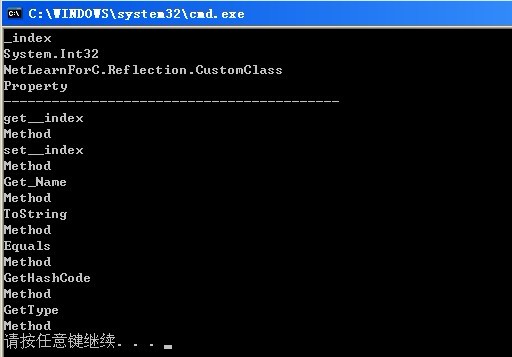那些年,我还在学习C# 学习笔记
C#是一门面向对象的语言,具有面向对象的基本特征,抽象、封装、继承、多态等性质。学习C#除了一些基本的语法,还得学习一些新的特性,比如说:泛型、多线程、集合、反射等,下面就选其中一些来学习吧!
一、C#中的各种器
A、 C#构造器-构造函数
如下:
代码如下:
//构造器1
public Products(int id)
{
_Id = id;
}
//构造器2,使用this来调用构造器1
public Products(int id, string Name, string Band)
: this(id)
{
_ProductName = Name;
_ProductBand = Band;
}
静态构造器-用来对类进行初始化信息,它不是显示调用的,在首次访问类时将自动调用,用来初始化类的一些基本信息而不是对象,但最好不要使用静态的构造器,代码如下:
代码如下:
static Products() { }//静态构造器
public Products() { }
B、初化器-在没有带参数的构造器时,我们可以用初始化器对对象的共公属性进行初始化
如下:
代码如下:
//产品的集合List
List<Products> ListProduct = new List<Products>()
{
new Products() { _Id = 1, _ProductName = "whc" },//使用{}是调有用初始化器,对属性进行初始化
new Products() { _Id = 1, _ProductName = "whc1", _ProductBand = "ctbu" },
new Products() { _Id = 1, _ProductName = "whc2", _ProductBand = "ctbu" }
};
C、终结器
终结器是在一次对象最后一次活动之后,并在程序终止之前执行。拉圾回收器会在回收过程中,找到带有终结器的对象,然后加入到终结队列,线程遍历完了,就调用终结队列上对象的终结器来回收资源
二、C#中那些重要的知识
A、委托与事件
委托
C#中将一个方法作为一个参数传递给其它方法使用,实现这样功能的模式叫做委托
1、委托的类型:是强类型,因为在声明委托方法时,指定的参数,在调用这个委托时必须传递相同类型的参数与参数个数
2、委托的内部机制:C#中所有的委托都继承自System.Delegate,但是我们不能继承它来实现自定义的委托,可以使用delegate关键字来定义
3、委托的定义:使用delegate关键字来使用
4、委托的实例化:定义一个与委托相同类型的函数,作为委托的参数传递,不需要用new关键字进行实例化,它可以通过委托推断,在C#1.0中,在传递方法时,需要用new delegate(Method)
5、委托的使用:
代码如下:
class DelegateClass
{
//一个泛型的委托,可以不同类型的参数进行处理
public delegate void AlculateMethod<T>(T first, T second);
}
class MehtodConllection
{
public void AlculateAdd<T>(T first, T second)
{
string third = first.ToString() + second.ToString();
System.Console.WriteLine(third);
}
public void AlculateDelete(int first, int second)
{
System.Console.WriteLine(first - second);
}
public void AlculateAddOther<T>(T first, T second)
{
string third = first.ToString() + "Hello Word" + second.ToString();
System.Console.WriteLine(third);
}
}
private static void _Demo4()
{
//方法的集合
MehtodConllection mc = new MehtodConllection();
//泛型的委托声明
DelegateClass.AlculateMethod<string> Demo = null;
//添加委托方法
Demo += mc.AlculateAdd<string>;
//
Demo += mc.AlculateAddOther<string>;
//调用方法,所有在委托中的方法都能被执行
Demo("str", "sterte");
}
事件
事件是一种特殊的委托,在声明委托时,添加一个event关键字
步骤:
1、定义委托的类型,相当于一个类,如: public delegate void ActionMethod();
2、定义事件委托变量,用1、中的委托类型定义,如: public event ActionMethod amd;
3、调用定义的事件,触发器,如:
代码如下:
class Cat
{
//定义委托方法
public delegate void ActionMethod();
//声明事件委托
public event ActionMethod amd;
//触发事件
public void CatShout()
{
System.Console.WriteLine("猫叫了,事件触发了!!!");
amd();
}
}
4、向事件中添加方法,将方法与事件绑定在一起,以便在触发时一起执行,如:
代码如下:
private static void _Demo15() {
Cat cat = new Cat();
HostPerson hp = new HostPerson();
Mouse mouse = new Mouse();
cat.amd += mouse.runing;
cat.amd += hp.WeekUp;
cat.CatShout();
}
5、最后触发事件
B、反射与特性
反射
1、反射的作用:
(1)、访问程序集中的元数据,比如说,方法属性修鉓符
(2)、使用元数据,在运行时动态的调用元数据的成员与属性等,而不是在编译时进行绑定
2、反射是择指对一个程序集中的元数据进行检查的过程,并且可以列举程序集的类型与属性,以及使用一些特定的对象调用上面的成员
3、使用System.Type访问元数据
类型的元数据System.Type是一个实例,这个实例提供了一些方法,这些方法可以列举元数据的成员,主要方法有以下几种:
Type.Name、Type.IsPublic、Type.BaseType、Type.GetInterface()、Type.Assemble、Type.GetProperties()、Type.GetMethod()、Type.GetField()、Type.GetCustomAttributes()等属性
(1)、使用GetType()得到元数据的类型对象(System.Type)
例:
类一:
代码如下:
class CustomClass
{
private string Name = "Test";
public string _Name = "Demo";
private int index { get; set; }
public int _index { get; set; }
private void GetName()
{
}
public void Get_Name()
{
}
}
类二:同时使用了typeof与GetType()来得到类型对象
代码如下:
public void Exec()
{
CustomClass cc = new CustomClass();
//得到当前类型的实例对象
Type type = cc.GetType();
//得到当前类型的实例对象使用typeof
//Type type = typeof(CustomClass);
//遍历public的属性,而不是字段,使用GetProperties()
foreach (PropertyInfo property in type.GetProperties())
{
//得到属性名
System.Console.WriteLine(property.Name);
//得到属性的类型
System.Console.WriteLine(property.PropertyType);
//得到反射的类型,就是反射对象的类名
System.Console.WriteLine(property.ReflectedType);
//得到成员类型,是属性还是方法
System.Console.WriteLine(property.MemberType);
}
System.Console.WriteLine("------------------------------------------");
//得到当前对象的公共方法,包含公共属性的方法get,set
foreach (System.Reflection.MethodInfo method in type.GetMethods())
{
//方法名
System.Console.WriteLine(method.Name);
//成员的类型
System.Console.WriteLine(method.MemberType);
}
}
结果:

//设置属性的值
property.SetValue(cc, 45, null);
//得到属性的值
System.Console.WriteLine(property.GetValue(cc, null).ToString());
MethodInfo demo = type.GetMethod("Get_Name");
demo.Invoke(cc, null);
得到一个无参的方法Get_Name,若有参null应为参数的数组
如: //调用有参的
代码如下:
MethodInfo test = type.GetMethod("GetName");
string[] param = { "12" };
test.Invoke(cc, param);
特性 (attribute)
1、特性是用来描述或修饰元数据的额外的信息,比如说:类、属性、程序集等
2、自定义特性,继承自Attribute类
如下:
代码如下:
class CustomAttribute : Attribute
{
public CustomAttribute();
public CustomAttribute(AttributeTargets validOn);
public bool AllowMultiple { get; set; }
public bool Inherited { get; set; }
public AttributeTargets ValidOn { get; }
}
[CustomAttribute(AttributeTargets.All)]
class CustomClass
{
[CustomAttribute(AllowMultiple = true)]
[Custom(Inherited = true)]
private string Name = "Test";
public string _Name = "Demo";
private int index { get; set; }
public int _index { get; set; }
}
C、扩展方法的使用与Lambda表达式
扩展方法
当你不能修改一个类的时候,扩展方法是一个方便给这个类添加其它方法的方式
1、扩展方法的定义:扩展方法使用this这个关键字,将一个方法绑定到this所指向的类型(如:类)的成员中对,从而就可以通过这个类的对象来调用这个方法,在MVC中,扩展,HtmlHelper类是很有用的,如下代码:
代码如下:
public static class PersonExtension
{
public static void Extension(this PersonSingle ps, string name)
{
System.Console.WriteLine("Name is " + name);
}
}
将Extension(string name)这方法添加到PersonSingle中去,然后就可以通过对象调用这个方法
PersonSingle类:
代码如下:
public class PersonSingle
{
public void Show()
{
System.Console.WriteLine("PersonSingle Method!!!");
}
}
private static void _Demo16()
{
PersonSingle ps = new PersonSingle();
ps.Show();
ps.Extension("whc");
}
2、扩展方法的访问权限要与所扩展的类的方法一致,这里都是public
3、扩展方法是写在一个静态类中的静态方法
Lambda表达式
Lambda表达式是一种比匿名方法更加简洁的一种匿名函数语法,其主要分为二类:一是语句lambda,二是表达式lambda
1、语句Lambda:是一种匿名方法的简化语法,其中不包含delegate关键字,只需要使用lambda运算符=>,是一个语句块
例:
代码如下:
Demo += (string first, string second) =>
{
System.Console.WriteLine();
};
2、表达式Lambda:是一个表达式,而不是一个语句块
例:
代码如下:
Demo = (first, second) => first.ToString();
3、Lambda表达式中能使用外部的变量
总结
那些年学习C#,作了一些笔记,此文大都直接从笔记中拷贝,当然还有很多没有提到,将在下次追加一些;此文以回忆那些年学习的日子。

